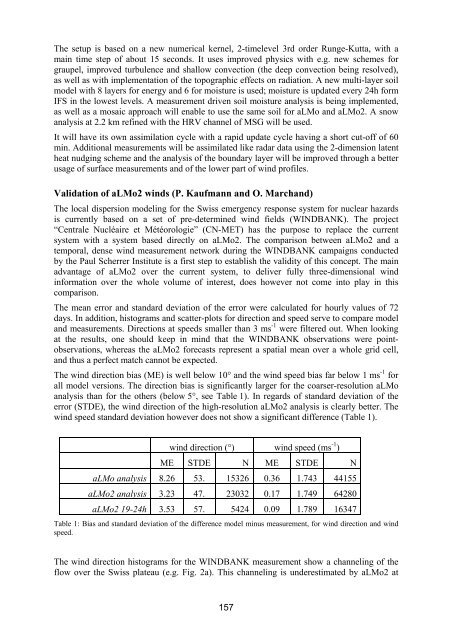Proceedings - C-SRNWP Project
Proceedings - C-SRNWP Project
Proceedings - C-SRNWP Project
You also want an ePaper? Increase the reach of your titles
YUMPU automatically turns print PDFs into web optimized ePapers that Google loves.
The setup is based on a new numerical kernel, 2-timelevel 3rd order Runge-Kutta, with a<br />
main time step of about 15 seconds. It uses improved physics with e.g. new schemes for<br />
graupel, improved turbulence and shallow convection (the deep convection being resolved),<br />
as well as with implementation of the topographic effects on radiation. A new multi-layer soil<br />
model with 8 layers for energy and 6 for moisture is used; moisture is updated every 24h form<br />
IFS in the lowest levels. A measurement driven soil moisture analysis is being implemented,<br />
as well as a mosaic approach will enable to use the same soil for aLMo and aLMo2. A snow<br />
analysis at 2.2 km refined with the HRV channel of MSG will be used.<br />
It will have its own assimilation cycle with a rapid update cycle having a short cut-off of 60<br />
min. Additional measurements will be assimilated like radar data using the 2-dimension latent<br />
heat nudging scheme and the analysis of the boundary layer will be improved through a better<br />
usage of surface measurements and of the lower part of wind profiles.<br />
Validation of aLMo2 winds (P. Kaufmann and O. Marchand)<br />
The local dispersion modeling for the Swiss emergency response system for nuclear hazards<br />
is currently based on a set of pre-determined wind fields (WINDBANK). The project<br />
“Centrale Nucléaire et Météorologie” (CN-MET) has the purpose to replace the current<br />
system with a system based directly on aLMo2. The comparison between aLMo2 and a<br />
temporal, dense wind measurement network during the WINDBANK campaigns conducted<br />
by the Paul Scherrer Institute is a first step to establish the validity of this concept. The main<br />
advantage of aLMo2 over the current system, to deliver fully three-dimensional wind<br />
information over the whole volume of interest, does however not come into play in this<br />
comparison.<br />
The mean error and standard deviation of the error were calculated for hourly values of 72<br />
days. In addition, histograms and scatter-plots for direction and speed serve to compare model<br />
and measurements. Directions at speeds smaller than 3 ms -1 were filtered out. When looking<br />
at the results, one should keep in mind that the WINDBANK observations were pointobservations,<br />
whereas the aLMo2 forecasts represent a spatial mean over a whole grid cell,<br />
and thus a perfect match cannot be expected.<br />
The wind direction bias (ME) is well below 10° and the wind speed bias far below 1 ms -1 for<br />
all model versions. The direction bias is significantly larger for the coarser-resolution aLMo<br />
analysis than for the others (below 5°, see Table 1). In regards of standard deviation of the<br />
error (STDE), the wind direction of the high-resolution aLMo2 analysis is clearly better. The<br />
wind speed standard deviation however does not show a significant difference (Table 1).<br />
wind direction (°) wind speed (ms -1 )<br />
ME STDE N ME STDE N<br />
aLMo analysis 8.26 53. 15326 0.36 1.743 44155<br />
aLMo2 analysis 3.23 47. 23032 0.17 1.749 64280<br />
aLMo2 19-24h 3.53 57. 5424 0.09 1.789 16347<br />
Table 1: Bias and standard deviation of the difference model minus measurement, for wind direction and wind<br />
speed.<br />
The wind direction histograms for the WINDBANK measurement show a channeling of the<br />
flow over the Swiss plateau (e.g. Fig. 2a). This channeling is underestimated by aLMo2 at<br />
157

















